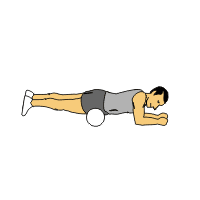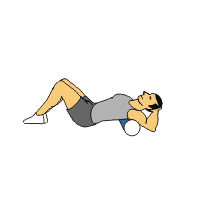Self myofascial release therapy (SMRT) is becoming more and more prominent amongst athletes who are looking for relief from injuries and their chronic aches and pains that are commonly associated with training loads.
Fascia & Trigger Points
Fascia is a specialized connective tissue layer surrounding muscles, bones and joints and gives support and protection to the body. It consists of three layers - the superficial fascia, the deep fascia and the subserous fascia. Fascia is one of the 3 types of dense connective tissue (the others being ligaments and tendons) and it extends without interruption from the top of the head to the tip of the toes.
Fascia is usually seen as having a passive role in the body, transmitting mechanical tension, which is generated by muscle activity or external forces. Recently, though, some evidence suggests that fascia may be able to actively contract in a smooth muscle-like manner and consequently influence musculoskeletal dynamics.
Trigger points have been defined as areas of muscle that are painful to touch and are characterized by the presence of taut bands. Tissue can become thick, tough and 'knotted'. They can occur in muscle, the muscle-tendon junctions, and / or bursa. Trigger points can be accompanied by inflammation. It is important to know that if trigger points remain untreated for a long duration, the once healthy fascia is replaced with inelastic scar tissue.
Trigger points can compromise the tissue structure in the area in which they are located, placing a greater strain on other tissues that must compensate for its weakness. These in turn can break down and so the spiral continues. According to many therapists, trigger points in the fascia can restrict or alter the motion about a joint resulting in a change of normal neural feedback to the central nervous system. Eventually, the neuromuscular system becomes less efficient, leading to premature fatigue, chronic pain and injury and less efficient motor skill performance.
Trigger points can be caused by:
- Acute physical trauma
- Poor posture or movement mechanics
- Over training
- Inadequate rest and recovery between training sessions
- Nutritional factors
Self myofascial release therapy is a relatively simple technique that athletes can use to alleviate trigger points. Studies have shown self myofascial release to be an effective treatment for myofascial pain syndrome and relief from injuries.
Listed below are some Self Myofascial Release Therapy exercises that you can perform yourself to help you RecoverBetter........
perform yourself to help you RecoverBetter........
For these exercises you will need a foam roller........

Adductor Self Myofascial Release.
1.Extend the thigh and place foam roll in the groin region with body prone (face down) on the floor.
2. Be cautious when rolling near the adductor complex origins at the pelvis.
Once a “tender point” is located, stop rolling, and rest on the tender point until pain decreases by 75%.

Hamstring Self Myofascial Release
1. Place hamstrings on the roll with hips unsupported.
2. Feet can be crossed so that only leg at a time is one the foam roll.
3. Roll from knee toward posterior hip.
Once a “tender point” is located, stop rolling, and rest on the tender point until pain decreases by 75%.

Quadriceps Self Myofascial Release
1. Body is positioned prone (face down) with quadriceps on foam roll
2. It is very important to maintain proper core control (abdominal drawn-in position & tight gluteus) to prevent low back compensations
3. Roll from pelvic bone to knee, emphasizing the lateral (outside) thigh
Once a “tender point” is located, stop rolling, and rest on the tender point until pain decreases by 75%.

Iliotibial Band Self Myofascial Release
1. Position yourself on your side lying on foam roll.
2. Bottom leg is raised slightly off floor.
3. Maintain head in “neutral” position with ears aligned with shoulders.
4. This may be PAINFUL for many, and should be done in moderation.
5. Roll just below hip joint down the outside thigh to the knee.
Once a “tender point” is located, stop rolling, and rest on the tender point until pain decreases by 75%.
 Upper Back Self Myofascial Release
Upper Back Self Myofascial Release1. Place hands behind head or wrap arms around chest to clear the shoulder blades across the thoracic wall.
2. Raise hips until unsupported.
3. Stabilize the head in a “neutral” position.
4. Roll mid-back area on the foam roll.
Once a “tender point” is located, stop rolling, and rest on the tender point until pain decreases by 75%.
General Guidelines
· Spend 1-2 minutes per self myofascial release technique and on each each side (when applicable).
· When a trigger point is found (painful area) hold for 30-45 seconds.
· Keep the abdominal muscles tight which provides stability to the lumbo-pelvic-hip complex during rolling.
· Remember to breathe slowly as this will help to reduce any tense reflexes caused by discomfort. · Complete the self myofascial release exercises 1-2 x daily.













